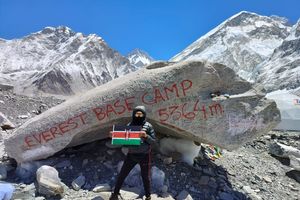Over half of world’s glaciers on pace to disappear, scientists warn

Mount Kenya: The glaciers and ice cap has been disappearing over the years. PHOTO | FILE
What you need to know:
- There are about 198,000 – 200, 000 glaciers in the world today, according to Antarctica Glaciers.
The future of glaciers now hangs in the balance, with over half of the glaciers globally predicted to disappear by the end of this century as a result of global warming, scientists warn.
This is even as glaciers on Mt Kenya shrink at an alarming rate due to rising temperatures in the region, signifying a clear impact of climate change.
The scientists drawn from Belgium’s Vrije Universiteit Brussel and Switzerland-based ETH Zurich set out to investigate all the glaciers in the world under different scenarios of carbon emissions. In a study published on The Cryosphere, they noted that glaciers are projected to shrink by 54 per cent by 2100 owing to rising levels of greenhouse emissions.
The scientists have particularly raised the alarm over increased risk of flooding in coastal cities and towns due to rising sea levels and melting glaciers caused by changing climatic conditions.
Glaciers vanishing from the face of the earth will be disastrous to humankind as it will also mean that freshwater, which the world’s populations depend on for drinking, will diminish enormously.
Prof Harry Zekollari, the research lead and glaciologist, explained: “The amount of water available for domestic use, farming, industrial processes, and the health of ecosystems will be impacted as glaciers act as a significant source of freshwater.”
Loss of glaciers will also reduce the ability of the Earth to reflect sunlight, causing the planet to turn a duller green as opposed to a shining white.
According to the scientists, the exposed rock and plant on the Earth tends to absorb more energy from the sun than reflecting, and it has a lower ability to reflect sunlight compared to the highly reflective white ice.
This will lead to “runaway effect” as lower sunlight reflection escalates climate change by intensifying the risk of the Earth becoming warmer. The researchers analysed past data on temperature, carbon emissions and glacier masses.
To predict the continued loss of the glacier masses resulting from global warming, they employed a computer modeling system.
“By modeling the evolution of glaciers under various scenarios of climate change through the entire 21st century, stark differences were found in the outcomes depending on future levels of emissions,” stated the research lead.
The researchers found that under high emission levels, 46 – 54 per cent of the glacier mass will have vanished by 2100.
In the optimistic event the carbon emissions remain low by the end of the century, the amount of glacier mass lost will be between 25 – 29 per cent.
While the loss of glacier mass will vary based on the geographical region, the findings show that some parts are more at risk and are estimated to lose over 75 per cent in the event of high emission levels.
The study further illustrates that some regions will retain a sizeable amount of their glacier mass but will still experience significant loss by 2100.
“Our findings agree with the new projections even though the sensitivity to changes in the climatic conditions is slightly more pronounced and there are some regional differences,” the study read.
The scientists explained that projecting the evolution of glaciers globally is crucial in measuring changes in rivers fed by glaciers and sea levels increases in future.
There are about 198,000 – 200, 000 glaciers in the world today, according to Antarctica Glaciers.
Glaciers are distributed in every continent including Africa, save for Australia.
According to experts, glaciers are key indicators of climate change because they change over a longer period as opposed to weather, and they are also different from ice sheets. A glacier is defined as snow and ice accumulation that flows over land.
Ice sheets, on the other hand, are masses of glacial ice which extend to over 50,000 square kilometres.
The Antarctica continent is home to nearly all of the world’s glaciers (91 per cent) followed by Greenland (eight per cent) North America (less than 0.5 per cent) Alaska (about 0.1 per cent) and Asia (0.2 per cent).
East Africa, Europe, South America, Indonesia and New Zealand have less than 0.1 per cent of the glaciers on planet Earth.
Kenya’s Mount Kenya, Mount Kilimanjaro in Tanzania near the Kenyan border and Ruwenzori Mountains in Uganda are home to Africa’s glaciers.
A new study published last year in the ‘Environmental Research: Climate’ shows that glaciers on Mt Kenya, Ruwenzori and Kilimanjaro are diminishing at an alarming rate as temperatures heat up in the region.
The glaciers in Kenya, Uganda and Tanzania have shrunk by nearly half in the last two decades and by 90 per cent over the past century, indicates the report.
The glaciers are highly vulnerable to global warming and rising carbon emissions as they are located closely to the equator.
Worldwide, glaciers have shrunk by 600 meters in the past century, according to the latest report by the Caucasus Environment Outlook.
Over 11 billion tonnes of freshwater, which had initially been stored in the ice has been lost since 2000, the report shows.





